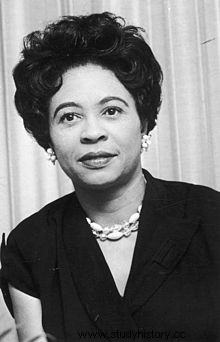Daisy Lee Gatson Bates (1914 – 1999) was an American journalist, editor and lecturer. She is also a civil rights activist.
[Warning:rape]
The impunity of murderers
 Adopted daughter of Susie and Orle Smith, Daisy Lee Gatson Bates was born on November 11, 1914, in Huttig, a small city in southern Arkansas (USA). Unaware at first that Susie and Orle are not her biological parents, she learns as a child that her birth mother was raped and murdered by three local white men. This discovery, as well as that of the impunity of the murderers, fills her with anger.
Adopted daughter of Susie and Orle Smith, Daisy Lee Gatson Bates was born on November 11, 1914, in Huttig, a small city in southern Arkansas (USA). Unaware at first that Susie and Orle are not her biological parents, she learns as a child that her birth mother was raped and murdered by three local white men. This discovery, as well as that of the impunity of the murderers, fills her with anger.
At fifteen, Daisy met Lucious Christopher Bates, an insurance salesman and her future husband. After a few years of relationship, they married on March 4, 1942 and moved to Little Rock (Arkansas). Upon moving to Little Rock, Daisy joined the local branch of the National Association for the Advancement of Colored People (NAACP), of which her father was a member before her. In 1952, at age 34, she became president of the Arkansas branch conference and, active in the movement, joined the national council in 1970.
The Arkansas State Press
The couple decides to invest in a common dream, the possession of a newspaper. Renting a printing machine, they start the Arkansas State Press , a statewide weekly. Composed of eight pages appearing on Tuesdays, the first copy was published on May 9, 1943. Committed and militant newspaper, the Arkansas State Press frequently publishes articles related to civil rights or featuring the accomplishments of black people in Arkansas. The newspaper became a fervent defender of civil rights, criticizing in particular segregation in schools.
The Little Rock Nine
In 1957, the Little Rock Nine crisis broke out. Little Rock schools are required by law to end school segregation and nine black students are expected in a school previously reserved for white students. Governor Orval Faubus orders the national guard to deny black students access to the establishment and violence takes place in front of the school, under the eyes of the authorities. Faced with the governor's illegal decision, President Eisenhower, removing Faubus from control of the state's National Guard, called in the state. Each of the nine students is assigned a soldier for their safety. Throughout the crisis, Daisy Bates is chosen to accompany and advise the nine students, as well as organize their entry into the school. On this occasion, she and some members of the NAACP are briefly arrested. Their newspaper lost advertising revenue during this affair and, unable to support itself, published its last issue on October 29, 1959.
The Long Shadow of Little Rock
In 1960, Daisy Bates moved to New York and wrote her memoir, The Long Shadow of Little Rock . Then moving to Washington, she worked for the Democratic Party. Within the administration of US President Lyndon Baines Johnson, she is involved in programs to fight poverty. In 1965, after a heart attack, she returned to Little Rock and then, in 1968, to the rural community of Mitchellville in Arkansas. She is dedicated to improving the quality of life of her fellow citizens by implementing programs to obtain new pipe systems, paved streets, a water system and a community center. In 1980, her husband died. After her death, Daisy resurrects the Arkansas State Press , which she sold in 1987 while continuing to work there as a consultant.
Daisy Bates died in Little Rock on November 4, 1999.
